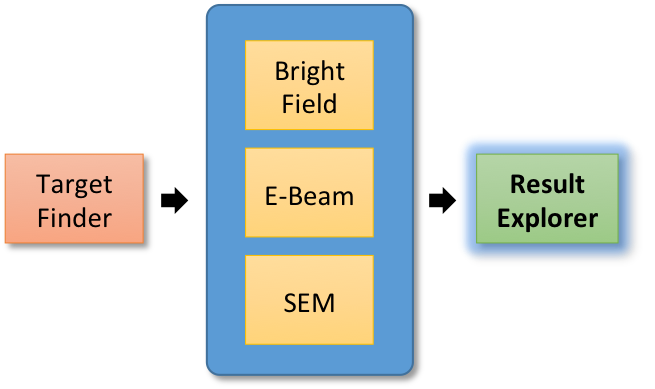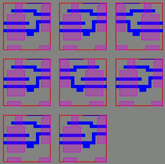Result Explorer

Converting large quantities of raw data into meaningful information is no easy task. When defect counts are high and large quantities of nuisance defects are known to exist, the task becomes even more difficult.
Result Explorer tackles this problem with a comprehensive set of design-assisted tools, key among them are Pattern Grouping and Signature Grouping.
Rather than provide a single form of pattern grouping, Anchor’s comprehensive approach means that several methods are offered:
Exact pattern grouping
Exact grouping can be performed with or without a specified amount of center shift to compensate for coordinate measurement error from inspection tools.
Pixel based similar pattern grouping
Because patterns aren’t always identical, this provides a means for taking small variations into account, thereby avoiding the creation of too many pattern groups. When there are 5,000 or 10,000 groups, the value to the user is greatly diminished because:
Design signature extraction and grouping
Whereas pattern grouping is based on the similarity of shapes, design signature grouping is based on the geometric properties that two or more shapes have in common. This is analogous to “feature vector” extraction and grouping in traditional image-based grouping algorithms. A set of geometric properties is extraction from each design clip (which is the pattern in the background of the reported defect) and then grouped on the basis of common properties. This further reduces the number of unique groups. For example, if the geometric property of “dense thin lines” is used, then all defect background clips having dense thin lines of specified dimensions will be grouped together regardless of what the patterns or shapes look like.
Result Explorer tackles this problem with a comprehensive set of design-assisted tools, key among them are Pattern Grouping and Signature Grouping.
Rather than provide a single form of pattern grouping, Anchor’s comprehensive approach means that several methods are offered:
Exact pattern grouping
Exact grouping can be performed with or without a specified amount of center shift to compensate for coordinate measurement error from inspection tools.
Pixel based similar pattern grouping
Because patterns aren’t always identical, this provides a means for taking small variations into account, thereby avoiding the creation of too many pattern groups. When there are 5,000 or 10,000 groups, the value to the user is greatly diminished because:
- Users cannot look at each of the 5,000 or 10,000 groups to determine which ones are more important and which ones are less important.
- It is much harder to create a good defect sampling strategy for SEM Review.
Design signature extraction and grouping
Whereas pattern grouping is based on the similarity of shapes, design signature grouping is based on the geometric properties that two or more shapes have in common. This is analogous to “feature vector” extraction and grouping in traditional image-based grouping algorithms. A set of geometric properties is extraction from each design clip (which is the pattern in the background of the reported defect) and then grouped on the basis of common properties. This further reduces the number of unique groups. For example, if the geometric property of “dense thin lines” is used, then all defect background clips having dense thin lines of specified dimensions will be grouped together regardless of what the patterns or shapes look like.
Exact Grouping with Center Shift
This is a variation of Exact Grouping. It compensates for the error or uncertainty in defect coordinates by allowing the user to specify the maximum amount of error or uncertainty. The grouping algorithm looks for exactly matching backgrounds within the user-specified radius.
Pixel Based Similar Pattern Grouping
Often there are subtle variations of a pattern. If exact grouping is used, each variation is placed into a separate group. In order to group a pattern and its variations into the same group, several options are available. Pixel Based Similar Pattern Grouping uses a bitmap approach in which the user specifies a grid size, and then a grid-by-grid comparison is made. If more than N% of grids match (where N is user specified), the patterns will be grouped together.
Signature Based Pattern Grouping
This grouping method uses pattern signatures that are extracted using “Signature Extraction” in Target Finder. Signatures are geometric properties rather than patterns. They include such items as density, average line length, min/max line width, min/max space, and numerous others. Patterns that exhibit a specified amount of common signatures will be grouped together.
Common Structure Extraction and Grouping
Instead of using the entire pattern for grouping, it is sometimes necessary to group pattern together if they contain a common structure (a common subset of polygons). This is especially useful in combination with Image Explorer, for example, which identifies the exact impacted polygons within a larger pattern. Additionally, common polygons within a set of patterns can be extracted directly. We can subsequently look for these impacted / common polygons within a collection of patterns, thereby splitting the collection into groups containing each common structure.
Topology Based Similar Pattern Grouping
Topology Based Similar Pattern Grouping is a shape-based algorithm (not pixel based) that groups patterns and their variations together if the variations differ only by specified amounts of line width and space. This is an easy way to specify pattern variation.
Main Benefits:
- Set of Linux functions that provide leading-edge pattern grouping and result analysis functions.
- Multiple pattern grouping algorithms are provided for both exact and ‘similar’ pattern grouping, allowing customers the flexibility to choose the most appropriate ones.
- Customers can embed these capabilities into their own automation workflows.
Main Features:
- Exact pattern grouping.
- Exact pattern grouping with Center Shift.
- Pixel based similar pattern grouping.
- Signature based similar pattern grouping.
- Common pattern extraction and common structure grouping.
- Defect cell hierarchy extraction.
- Data plot.
- Statistical analysis.
Result Explorer is an upgrade of HPA:
- Existing HPA customers may contact Anchor Semiconductor for details on obtaining this upgrade.
- HPA will continue to be supported with bug fixes (patches).

Technical Requirements
The minimum system requirements are listed below:
Memory and hard drive requirements can vary substantially from customer to customer. Customers who expect to store large quantities of images on the server should allocate appropriate hard drive capacity. Customers who expect to process large numbers of images should allocate additional physical memory. Anchor Semiconductor will help each customer with the appropriate sizing of their hardware.
- Linux 2.6 or later, 64-bit, x86 based processor.
- 16 or more physical cores.
- 128 GB or more physical memory.
- 2 TB or more available hard drive capacity.
Memory and hard drive requirements can vary substantially from customer to customer. Customers who expect to store large quantities of images on the server should allocate appropriate hard drive capacity. Customers who expect to process large numbers of images should allocate additional physical memory. Anchor Semiconductor will help each customer with the appropriate sizing of their hardware.





